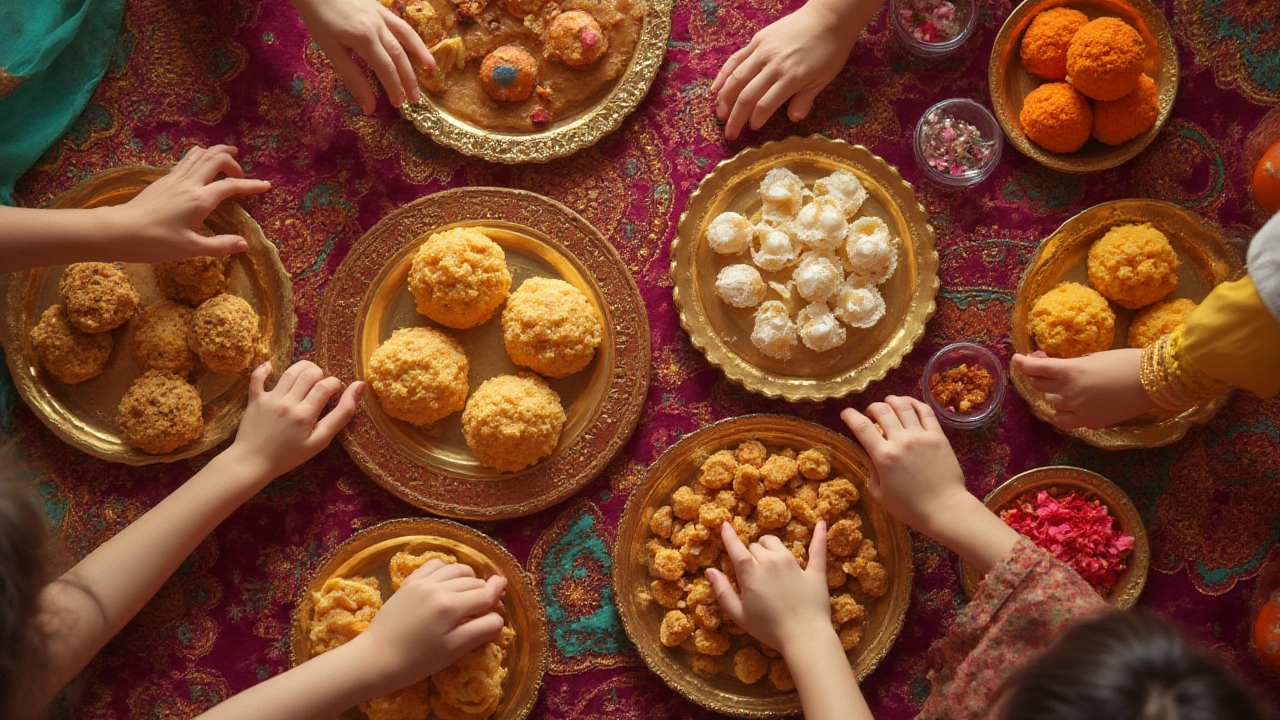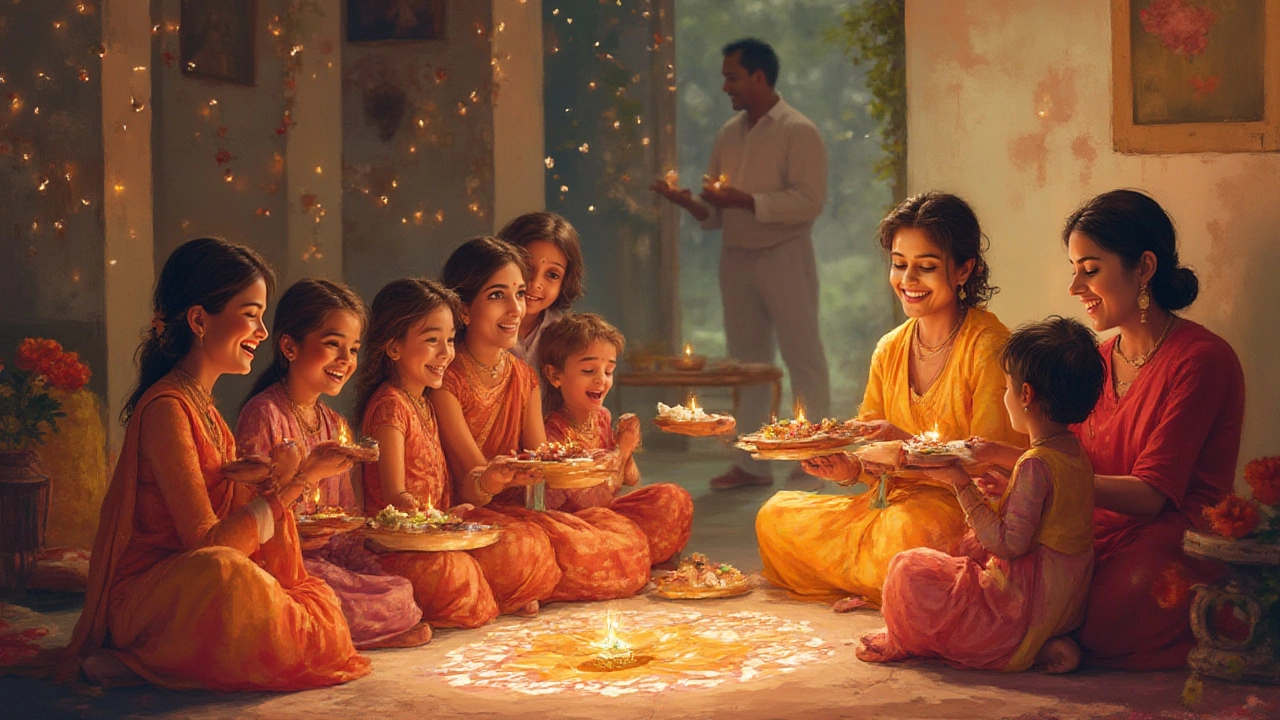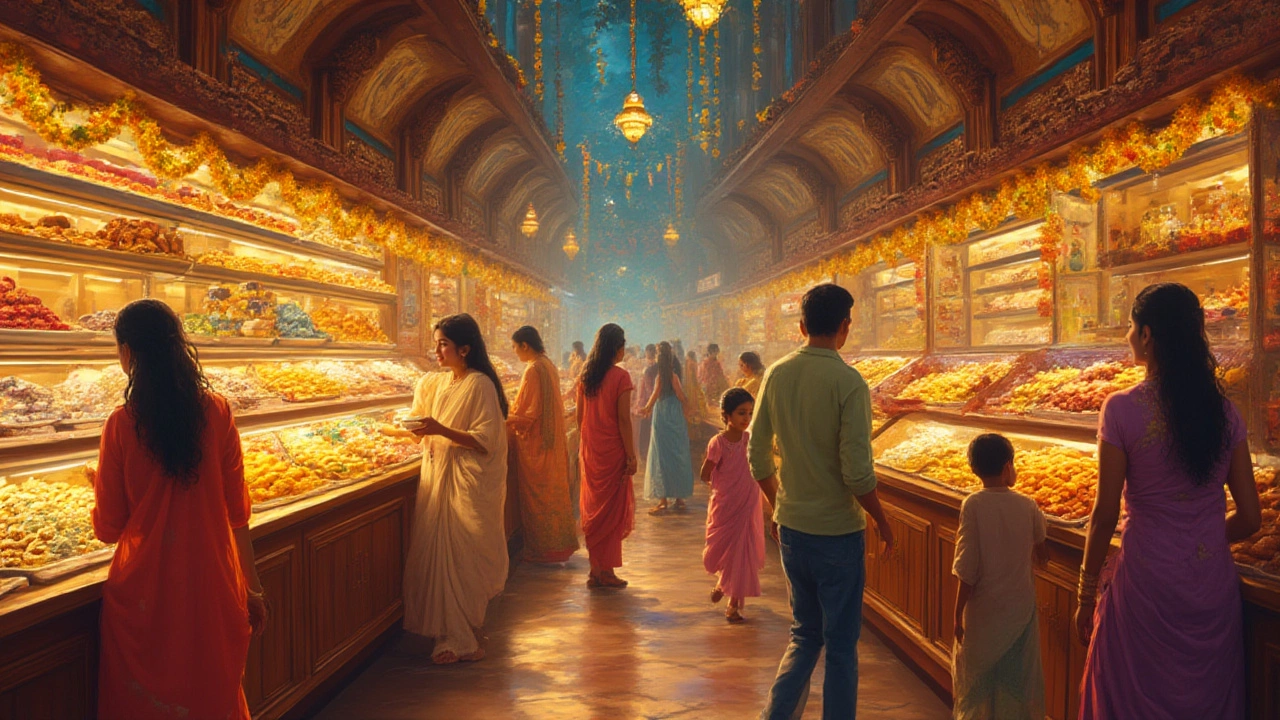Sweet cravings in India are not just about taste; they’re woven into daily life, celebrations, even heartbreak. Forget Western assumptions about ‘a little dessert after dinner’—in Indian culture, sweets have a whole storyline of their own. The variety is staggering, with every region and sometimes even every family having its star recipe. If you’re visiting an Indian home, odds are you’ll be offered at least one kind of sweet, and it’s not simply to satisfy a sugar rush—it’s a welcome, a blessing, and sometimes a show of pride.
The Most Beloved Mithai: What Defines Indian Sweet Tooth?
There’s this funny expectation many people have: that Indian sweets are just a mountain of sugar with a few nuts sprinkled in. The truth? The range is mind-blowing, and each sweet—called "mithai"—has a personality of its own. Let’s talk about Indian sweets that actually get people excited. Gulab Jamun, those golden, deep-fried milk balls dunked in syrup, top every popular list. Walk into any Indian celebration—weddings, birthdays, Diwali parties—and you’ll spot a pile of glistening Gulab Jamuns. They’re soft, warm, melt-in-the-mouth, and for some, a reason to break any diet. But why are these so loved? The process of making Khoya (milk solids), kneading it just so, then getting the temperature right while frying—that’s where the magic happens. Too cold and Jamuns turn hard; too hot and the outside burns. Then there’s Rasgulla, hailing from Bengal. Rasgulla’s bouncy white orbs come from chenna (fresh paneer) cooked in sugar syrup. A bite gives a burst of syrup, so light you almost forget the sweetness.
Next, barfi makes its appearance. It’s not one single thing; it’s a whole group of fudge-like squares made from condensed milk or coconut. Some versions sparkle with edible silver foil, some are studded with pistachios. And don’t get me started on jalebi, the bright orange crunchy spirals soaking in syrup—eaten hot with rabri (thickened milk) in North India at wedding breakfasts, or just grabbed from the street corner sweet shop as a snack.
What really surprises people is how regional preference comes into play. Take Mysore Pak, a crumbly, almost powdery sweet made of gram flour and ghee, famous in Karnataka. In Rajasthan, people have a soft spot for Ghevar, a honeycomb-like disc, especially during festivals. In the East, Sandesh is more popular, a sweet made with fresh chenna, light and often flavored with cardamom or mango. Then down south, coconut takes centre stage, with treats like Coconut Ladoo and Payasam (a creamy milk pudding). Each of these is more than a recipe—it’s a chunk of local history.
Even Indian cinema and TV are peppered with references—think about Shah Rukh Khan’s character in "Kabhi Khushi Kabhie Gham" struggling to resist laddus, or families in every Hindi soap revealing secrets over boxes of mithai. Sweets here aren’t just about sweetness. They symbolize prosperity, mark every major ritual, and sometimes, even serve as a peace offering after a big family squabble.
For those wary of the sugar content, there are modern spins too. Some sweet shops now offer sugar-free mishri mawa, or low-calorie soan papdi, meeting the needs of diabetics or the health conscious, which almost feels like sacrilege to purists but is gaining ground in cities.

Occasions, Rituals, and Everyday Life: When and Why Do Indians Eat Sweets?
Ever wondered why a sweet is almost mandatory at Indian gatherings? It’s because mithai isn’t just food—it’s a sign of sharing joy, luck, and hope. New job? Pass around a box of Kaju Katli (cashew fudge). Housewarming? Distribute Motichoor Laddus. Got engaged? Here comes a silver tray stacked high with sweets. The tradition goes so deep that no religious festival ever feels complete without a plate full of mithai. Diwali—the festival of lights—is honestly its own Olympics of sweets. Households prep for weeks: making Kheer (rice pudding), Besan Laddus, and gujiya. You’ll spot queues outside local halwai (sweet shops) the morning of every big festival, people juggling boxes and selecting favorites.
Birthdays start with someone feeding the cake or mithai to the guest of honour—often from their own hands, which can feel intimate or slightly awkward, depending on your comfort with personal space. Visiting someone recovering from an illness? Sweet treats are a must. Even at times of grief, a simple sweet like peda or plain barfi brings some comfort. And yes, teachers’ day, farewell parties, graduation—there’s mithai everywhere, shining through every milestone.
It’s not all about big days, though. A lot of families keep simple sweets at home for impromptu guests—a jar of sohan papdi, some store-bought Mysore Pak, or just jaggery and peanuts rolled into bites called chikki. In North India, chai time almost demands a nibble of sweet. In the South, an after-lunch payasam rounds off the meal, no special occasion needed. Lunch trays in some regions come with a square of halwa or a mini rasgulla on the side, especially in business hotels and wedding banquets.
It’s fascinating how sweets have a whole etiquette around them. If you get a box of sweets as a gift, the polite thing is to open it right away and offer it to everyone present; it’s unlucky to deny or delay sharing. When sending wedding invitations even now, many families include a tiny box of mithai alongside the card. Abroad, Indian communities try to keep up the tradition, importing sweets or trying their hand at making versions with local ingredients—condensed milk barfi in London or coconut halwa in Toronto’s desi supermarkets.
But tastes are evolving. Urban Indians—especially the younger crowd—are now mixing things up, swapping classic sweets for chocolate truffles dusted with cardamom or cheesecakes spun with gulkand (rose jam). Ice cream shops offer falooda and kulfi in flavours like paan, saffron, or even filter coffee. So while the old favorites are going strong, you can feel change bubbling under the sugary surface.

Tips, Surprises, and Lesser-Known Sweets Across India
If you’re eager to try Indian sweets, my advice is: be adventurous. Don’t just stick to the usual suspects—ask for what’s fresh at your local shop. If you ever spot Patishapta in a Bengali home, which is like a crepe filled with coconut and jaggery, grab it before it disappears. In Maharashtra, Shrikhand—a chilled yogurt dessert flavored with saffron—is a summer powerhouse. Puran Poli, a stuffed flatbread with sweetened dal, blurs the line between dessert and main course, so don’t be shocked if you see people eating it with a dollop of ghee for breakfast.
Travel through India and chances are you’ll bump into sweets you’ve never heard of. Khaja from Odisha is a flaky, layered pastry dipped in syrup, eaten during temple festivals. Kerala has unni appam—mini banana fritters, addictive with a cup of filter coffee. Some regions go savory-sweet, like the Gujarati Mohanthal or the Sindhi Sev Barfi. Down south, seedais and adhirasams fill platters during Tamil New Year, a treat if you like the deep flavors of jaggery and cardamom. If you find yourself in Punjab during winter, don’t miss pinnis—wheat and jaggery balls rich with ghee, meant to keep you warm when the fog rolls in.
For anyone with a sweet tooth living—or just grocery shopping—outside India, here’s a little insider tip: Sweets freeze better than you'd guess. Some, like laddus and barfi, actually get firmer and tastier after a week in a sealed tin. Rasgullas from trusted brands arrive canned and keep in the fridge for months, though the syrup may need a quick boil to refresh. Trying your hand at homemade sweets? You don’t need fancy gear. Most classic sweets use things like a frying pan, a sieve, and your own (clean) hands for shaping balls or kneading dough. The trickiest part is usually getting the sugar syrup to the perfect single-thread consistency—get this right and you’ll feel invincible!
A last little fun fact: Sweets in India sometimes aren’t strictly ‘desserts’—many are eaten at breakfast (like jalebi and poha), or even as snacks on a hot afternoon. And if a sweet gets a bit stale, some enterprising soul will crumble it onto ice cream, or mash it with milk to create something new. This creativity, this refusal to let a sweet go to waste, is how Indian sweets keep refreshing themselves across generations and borders.
